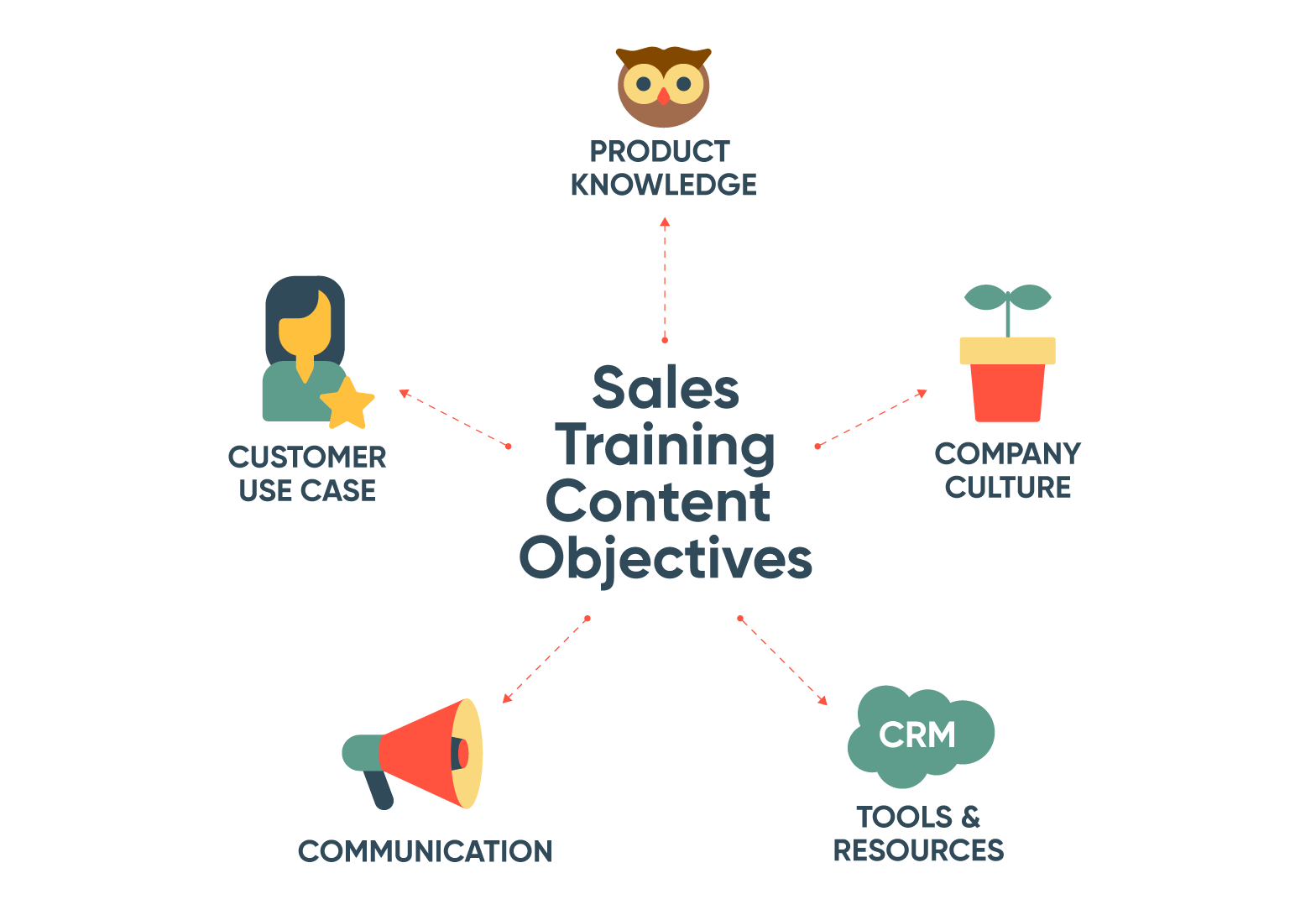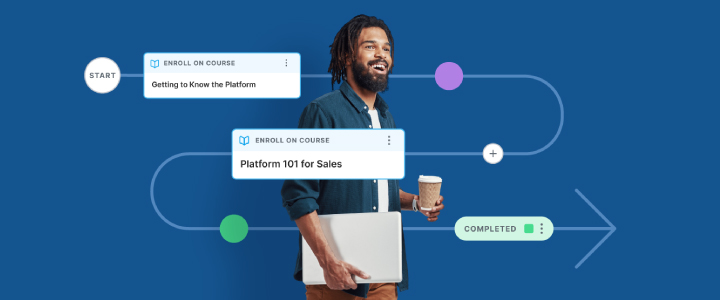
7 min reading time
How to Build a Strong Sales Training Program for your Business
The role of a salesperson should go beyond just reaching out to prospects and doing a demo. It’s about them fully understanding your customers and their problems, knowing how to talk to them, and offering real insight into how your business can actually help them. This is what wins long-term deals.
This is easier said than done; only 10.7% of sales training programs exceed salespeople’s expectations, 42.5% meet expectations, and 43.5% need improvement. As a business, you should strive to be in the first group – exceeding expectations. The reason? On average organizations that have implemented sales training that exceeds expectations, achieve a 10% higher win rate, lose almost 5% fewer deals, and lower sales rep turnover by 10%. That’s a lot of revenue.
Today, let’s take the first step to building a strong, revenue-driving sales training program. By sharing our experience here at LearnUpon, as well as what we’ve learned from our customers, this guide will help your team shape and improve its sales training program.
The goal of sales training
In the past, training for sales teams had a bad habit; it was myopic. It focused on educating salespeople on the product and maybe a little on best practices, but it was limited. In today’s world, that doesn’t cut it anymore. Customers and prospects want, expect, and need more.
To reach the big goal of positively impacting your bottom line, you need to look beyond just sharing information on your product. You need to give your sales team the tools they need to take a consultative, partner building approach.
To do this, at LearnUpon, we investigated what training would help with this process, which in turn would help build relationships between our salespeople and our customers. From this, we created “mini” learning objectives that, when tied together, created a comprehensive training strategy that leads to our overall goal – more sales. Here’s what we believe should be prioritized throughout the training: 
1. Product
Every salesperson should know your product inside out. This means understanding the users’ perspective, what they want to achieve with the product, what each feature does, and how it helps them solve their problem. Embedding this knowledge into your Sales team means they can competently show your product in the best light, and answer every question a customer has about it.
2. Communication
How do you want to talk to your customers? Do you take a formal or more casual approach? What questions do you ask a prospective customer? These are integral things that your salespeople need to know. By establishing and teaching them a set tone of voice and cadence, they’ll be able to effectively interact with customers to clearly communicate who and what your business is.
3. Customer use case
Who are we selling to? If not properly communicated, this can lead your business down the wrong path. If your Sales team knows their core audience, they understand why this potential customer is interested in your product, the problem they want to solve, and successfully sell to people who are more likely to stick around in the long run.
4. Tools and resources
Within every organization, there’s a system of tools used by the Sales team and its key that each one of them knows how to correctly use them. For example, in order to communicate and track your prospective customers, your salesperson needs to understand how to use your CRM and how it interacts with other sales tools your team is using.
5. Company culture
Team and company culture is something we focus heavily on in LearnUpon. We believe every organization that puts its customers at the heart of everything they do should too. This means that from the get-go, your employees are instilled with the values of their team and wider organization That they know their coworkers, and the business’s history, to ensure everyone is working towards a common goal.
Face-to-face vs online sales training
Traditionally, sales training has been done in person with a manager or other members of the Sales team. This is great as your salesperson can interact, ask questions, and receive feedback, face-to-face.
But, that’s no longer your only option. Increasingly, businesses are moving to online training platforms, like learning management systems. The reason? Online training is scalable, its impact is measurable, and it enables your organization to train staff no matter where they are. In today’s world most fast-growing companies, have multiple offices. With a Sales team based in a Heuston HQ, but also having team members in London and Sydney, face-to-face training won’t work here. It needs to be online.

For us, the sweet spot is somewhere in the middle. We take a blended learning approach. Those in our headquarters, where our Sales team is based, do face-to-face and online sessions, and those in our international offices, train online.
Designing a sales training program
After identifying the what’s and how’s of training, it’s time to plan how you’re going to create, manage, and deliver your program.
1. Planning
How you approach the planning of your sales training will be unique to your organization. Different processes, different industries, and different products are at play, but there are some universal steps that every business can, and should, take.
Whether you’re at the beginning of planning a formalized sales training process or trying to improve the one you already have, it’s clever to start by looking back on the previous training that was being done. Assess what was being learned, how it was delivered, as well as what went right and wrong.
From here, you can start to look at what training you’ll be delivering and when’s the best time to deliver it. At LearnUpon, we did this by figuring out how long our sales onboarding process would take – six weeks. Each week had set courses and complementary tasks that had to be achieved in order to progress to the next week’s training. We started with the easier elements then slowly built on them. The ultimate goal was that after the six weeks of intensive training the salesperson would be able to deliver a full product demo to the rest of their team.
At this stage, it’s a good idea to identify the formats you’ll use to deliver your training content. What courses will be online in your LMS? And what, if any, are going to be face-to-face sessions? Will there be videos, live webinars or presentations? Knowing this will add structure to the training and enable your team to effectively implement the strategy.
2. Accessibility to training
After your team has planned the training, you’ll need to decide how this training will be accessed in your LMS.
When using your LMS to deliver and manage sales training, you should connect it to your HR system. This means that when a salesperson joins and is added to the HR system, they’re automatically added to the LMS too. And on day one, they can get instant access to all of their training. Alternatively, if you have a smaller team, you can add them via CSV.

To ensure that the salesperson understands exactly what’s involved, you should walk them through the training process asap. Informing them of the courses they need to take and their deadlines, ensures they’re fully aware of the process, know where to find the materials they need, and most importantly, are more likely to reach their goals.
3. Automating management
If you’re a fast-growing organization that continuously has new team members joining, it’s paramount that you make managing sales onboarding training as simple as possible. This is where your LMS can really help out.
When a learner is added to the LMS, they can be automatically assigned to a group. Who is added to this group is based on predefined criteria that you select in the LMS. For example, your groups could be based on the position of the salesperson joining or determined by who their trainer is. You can assign courses to all members of a group at once, instead of individually enrolling each new member into every single course.
On top of this, Learning paths are another helpful LMS feature that automates tasks and makes sure that a team member is getting all the training they need. Perfect for a sales onboarding plan, it works by tying a selected number of courses together. You can then enroll a learner, or group of learners, into the learning path. Once the first course is completed or after a certain period of time, the next course is unlocked so your learner can continue the training without intervention from you.
4. Testing your trainees
Once you’ve planned the training and know-how to manage it, how do you measure if your salespeople are actually absorbing and retaining what’s being taught?
If you’re using the blended learning model, it’s a good idea to mix up how you assess your team. For example, within the LMS, there can be a weekly assignment that needs to be completed by the end of the week. We’re fond of this method at LearnUpon, as we get our learners to complete 6 to 8 assignment tasks. Be it quizzes, true or false questions, or an uploaded recorded video, it ensures the salespeople are grasping all the knowledge they need.
To make it more blended and personalized, you can also run a webinar or in-person session. Your salespeople can demo what they’ve learned over the past week, gain confidence talking about the product, and get face-to-face, real-time feedback from other team members.
5. Measure and iterate
Once the training period is over, that doesn’t mean the process is done. As an organization, you should measure the success of your training. Based on your KPIs, for example, ROI per salesperson or onboarding time, you can use the reports in your LMS and compare this to the results your Sales team was achieving before this training strategy was implemented.
From here, you can see the wins of the training program, and importantly, find the elements that aren’t working and improve on them. This way you’ll achieve meaningful results that impact the most critical parts of your business, like your bottom line.
Are you planning on implementing a sales training program? Let us know about your experience in the comments below.



